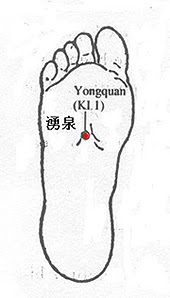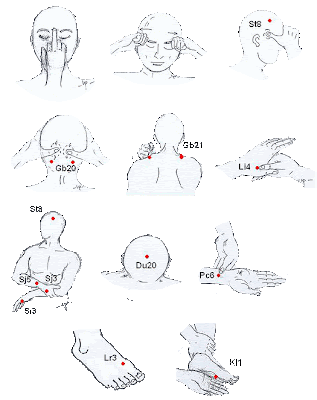In China, herbal bathing is an ancient tradition, and it is recorded that early in the
Zhou dynasty (approx. 1100-221 BC) people started to use Eupatorium (pei lan) in baths to get rid of body odor. This fragrant herb is a common ingredient to relieve
summer heat symptoms and to promote appetite. It was not until the
Song dynasty (AD 960-1279) that herbal baths became popular among the general public, and as an integral part of rituals. Some examples are:
An ancient bathing scene
During Chinese New Year, people take a five-fragrance bath for relaxation, in which contains the common bluebeard herb, Schizonepeta herb, common basil, sandalwood and costus root;
During spring, people take wolfberry-fruit baths which is said to promote skin health and delay aging;
During summer, people take five-twig-bath for health prevention and maintenance; this bath contains cassia twig, pagoda twig, peach twig, willow twig and ephedra.
Chinese herbal baths are generally indicated for conditions like fever, fungus infections, skin sores, wounds, pain, arthritis, and itchiness, as well as a beauty treatment. The effective components of the herbal bath are mainly absorbed through the patient's skin and respiratory system and work by activating the potential life functions in the patient's body. Selection of herbs is usually based on specific conditions.
At home, you can mix an infusion or decoction to fill the bath or use a large gauze bag stuffed with the proper herbs (ground) to steep your own bath. When preparing the decoction, soak the herbal ingredients for 20 minutes first and then boil for 30 minutes. It is said that the same pack of herbs can be decocted three times. When taking herbal baths, the water temperature should lie between 37 - 42℃, rub the body surface slightly and soak in the bath for no longer than 30 minutes. After the bath, rinse the body with plain water, remember to rest for half an hour and drink water to replenish lost body fluid.
1. Healthy skin
Ingredients
Cochinese asparagus root (24g), almond, ampelopsis, silkworm, largehead atractylodes root (18g each), Dahurian angelica root (12g) and milk (500ml). The ingredients promote blood circulation and lubricate the skin.
Methods
Grind all the herbal ingredients, put in a gauze bag and decoct for 20 minutes. Pour the liquid and milk into warm water (around 38℃); soak for 30 minutes.
Ingredients
Ginger juice (30ml), vinegar (15ml) and wine (50ml). The ingredients improve skin texture.
Methods
Pour into warm water (around 38℃); soak for 30 minutes.
Ingredients
Seaweed, safflower, motherwort herb (9g each), red sage root (6g),
Methods
Grind the herbal ingredients, put in a gauze bag and decoct for 20 minutes. Pour the liquid into warm water (around 38℃); soak for 30 minutes.
2. Excess Weight
Ingredients
Dried winter melon peel (300g), poria (300g), quince fruit (100g), perilla leaf (100g) and dried tangerine peel (100). The combination promotes metabolism and enhances sweating and urination. See
pictureMethods
Prepare a decoction with the ingredients. Water temperature should be lie between 39 - 42℃; soak for 10 minutes, then leave the bathtub to cool down for 3-5 minutes, repeat 4 times. A bath twice a day is recommended.
Ingredients
Pilose asiabell root (9g), angelica root (9g), safflower (30g) and rose (30g). The combination promotes metabolism by enhancing blood circulation.
Methods
Grind into a powder mixture, each time pour 30g into bathtub directly, keep the water temperature between 39 - 42℃ and soak for 20 minutes. Take the bath daily, 10 times as one cycle.
3. Skin sores
Ingredients
Mulberry fruit (15g), hemp seed (9g), clove (6g) and Chinese lovage (10g); this combination promote the circulation of the skin and aid body lubrication; See
pictureMotherwort herb (500g); the herb reduces the swelling of the sores;
Selfheal fruit spike, honeysuckle flower, red peony root and diverse wormwood herb (30g of each), dahurian angelica root (20g) and dandelion (60g); the combination arrests inflammation and promotes healing.
Methods
Prepare as a decoction; the water temperature should be about 38℃ and soak for 30 minutes.
4. Arthritis
Ingredients
Mulberry twig (500g), erythrina bark (60g), Siegesbackia herb (100g), Kadsura stem (100g), Star jasmine vine (200g), honeysuckle stem (60g) and Suberect spatholobus stem (60g); the ingredients encourage circulation in the joint and lessen pain. See
pictureMethods
Prepare as a decoction; the water temperature is 38℃ and soak for 20 minutes.
Ingredients
Giant knotweed rhizome, peach twig, willow twig, mulberry twig and pagoda twig, 250g of each. The combination expels any obstruction and promotes circulation.
Methods
Prepare as a decoction; the water temperature is 38℃ and soak for 30 minutes.
5. Insomnia
Ingredients
Sour jujube seed (30g), Mimosa tree bark (15g), fleece flower stem (20g), nacre (30g), Chinese senega (30g), fossil bone (30g), oyster shell (30g), lily buds (30g), red sage root (30g), acorus (15g),
schisandra (30g) and gardenia fruit (30g). The ingredients calm the mind and depress the excited state. See
pictureMethods
Prepare as decoction, the water temperature is around 38℃, soak for 20 minutes.
Ingredients
Jasmine (15g), rose (9g), poria (processed) and nutgrass (15g each). The ingredients calm the mind and smooth qi flow.
Methods
Grind all the ingredients and pour directly into warm water (38 - 42℃); soak for 30 minutes.
6. Summer heat
Ingredients
Mosla herb, cablin patchouli herb, eupatorium herb, perilla leaf (30g of each); peppermint, Schizonepeta herb, Kudzu vine root and liquorice root (20g of each); golden thread rhizome (9g); the ingredients clear heat and resolve dampness, which is good for refreshment and preventing heat rash in summer. See
pictureMethods
Prepare as a decoction; the water temperature should be 35℃ and you should soak for 30 minutes, bathe in the afternoon or evening.
7. Wheal
Ingredients
Schizonepeta herb and sopora root (30g of each); peppermint, Siberian cocklibur fruit and Chinese cypress bark (20g of each); cicada slough and ledebouriella root (12g of each); the ingredients help to sooth the skin. See
pictureMethods
Prepare as a decoction, the water temperature is 39℃, soak for 30 minutes, avoid wind blowing after bathing.
8. Itchiness
Ingredients
Ledebouriella root (30g), fresh rhemannia root (30g), notopterygium root (20g), schizonepeta herb (20g), common monkshood mother root (10g), Kusnnezoff monkshood root (10g), belvedere fruit (40g), cnidium seeds (60g) and duckweed (100g). The ingredients help to sooth the skin, promote circulation, and expel wind and heat pathogens.
Methods
Prepare as a decoction, the water temperature is around 38 - 42℃, soak for 30 minutes, avoid wind after bathing.
9. Neck and shoulder soreness
Ingredients
Fleece flower root, suberect spatholobus stem, mulberry twig, cassia twig (15g each), safflower (9g). The ingredients promote blood circulation and relieve muscular soreness.
Methods
Prepare as a decoction, the water temperature is around 38 - 42℃, soak for 30 minutes.
Herbal baths are not suitable for children, the elderly or seriously ill people. It is also not recommended for individuals who have a tendency to bleed easily, or who have heart, lung and kidney problems.
































